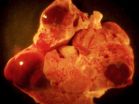New study finds reminders for immunizations challenging for pediatric practices
2011-01-26
(Press-News.org) AURORA, Colo. (Jan. 25, 2011) – A new study led by researchers at the Children's Outcomes Research (COR) Program at The Children's Hospital and Colorado Health Outcomes Program (COHO) at the University of Colorado School of Medicine explores the barriers, facilitators and alternative approaches to providers sending reminder notices for immunization using a statewide immunization registry. Reminder or recall messages, usually in the form of postcards, letters, or phone calls, have long been regarded as an effective way to increase immunization rates within primary care settings, particularly among young children. Despite evidence of the effectiveness of recall, the study found that initiating and sustaining recall activities within private practices remains difficult.
The study, Getting under the hood: exploring the issues that affect provider-based recall using Immunization Information System, publishes today in Academic Pediatrics.
Alison W. Saville, MSPH, MSW, project manager within COR, along with Principal Investigator Allison Kempe, MD, MPH, also of COR, and their team of local and national researchers were interested in researching this to determine why recall was so underutilized by physicians in practice, despite its demonstrated effectiveness at increasing immunization rates in young children. The Colorado Immunization Information System (statewide immunization registry) offers a web-based tool to create a list of children who are behind on immunizations that can generate mailing labels or a phone list.
"This is the first study to explore the real world issues that influence private practices' decisions to implement an evidence-based intervention to increase immunizations,"
said Saville.
According to Saville, the objectives of the study were to assess (1) pediatric practices' use of provider-based recall using an Immunization Information System (IIS) eight months after training on the recall process; (2) find barriers to provider-based recall using an IIS; (3) come up with strategies that facilitated recall initiation; and (4) create recommendations for alternative approaches for conducting recall.
In 2008, 11 practices received training on the automatic recall function in Colorado's IIS (CIIS) for both infants and adolescents. The two-hour computer-based training provided an opportunity for attendees to run real-time recall reports with CIIS staff assistance. Eight months later, key informant interviews were conducted with 24 providers and staff from these practices.
Study results showed that eight months after training, only four out of 11 practices had implemented recall using CIIS—three practices recalled children two years of age and under and one practice recalled adolescent females for the Human Papillomavirus vaccine. Resistance to using the System included lack of awareness of baseline immunization rates, distrust in the accuracy of CIIS generated data, and perceived difficulties recalling adolescents. Having unrealistic expectations about recall effectiveness was a barrier to sustainability.
Strategies that facilitated recall included having a dedicated staff person for recall efforts and recalling children two years of age and under. The majority of key informants viewed population-based recall conducted by public health departments or schools as an acceptable alternative to provider-based recall.
"Even with a promising tool to assist pediatric offices, implementing provider-based recall is challenging for pediatric practices," said Saville. Given existing barriers, providers expressed support for alternative recall methods.
Currently, there is no research comparing the effectiveness of provider-based versus population-based recall. Such research is needed in order to determine the most effective and cost-effective methods for getting children up-to-date with immunizations at the population level. Researchers at COR were recently funded by the NIH to directly compare practice-based versus centralized public health based methods of recalling children at the level of the county.
###
The University of Colorado Denver offers more than 120 degrees and programs in 13 schools and colleges and serves more than 28,000 students. For more information, visit the UC Denver Newsroom.
END
ELSE PRESS RELEASES FROM THIS DATE:
2011-01-26
COLUMBIA, Mo. – One of the first studies published from the University of Missouri Brain Imaging Center (BIC) gives researchers insight into the brain and memory and may provide researchers clues to treating a variety of debilitating disorders.
Nelson Cowan, director of the BIC and Curator's Professor in the Department of Psychological Sciences, used the BIC's magnetic resonance imaging (MRI) to produce graphics that depict the structure and function of the brain during various mental tasks in an effort to understand abstract working memory. People use their abstract ...
2011-01-26
DURHAM, NC – Duke University bioengineers have developed a new method for rapidly producing an almost unlimited variety of man-made DNA sequences.
These novel sequences of recombinant DNA are used to produce repetitive proteins to create new types of drugs and bioengineered tissues. Current methods for producing these DNA sequences are slow or not robust, the researchers said, which has hindered the development of these increasingly important new classes of protein-based polymers.
Researchers have already demonstrated that when a large protective macromolecule – known ...
2011-01-26
Surgery has not been an option in the past for children with ACL tears because of the possible damage to the growth plate that can cause serious problems later in life.
With this new technology, surgeons can actually see from one point to the other on either side of the knee, and can safely position the tunnels where they will place the new ligament.
John Xerogeanes, MD, chief of the Emory Sports Medicine Center, and colleagues in the laboratory of Allen R. Tannenbaum, PhD, professor in the Wallace H. Coulter Department of Biomedical Engineering at Georgia Tech and ...
2011-01-26
WASHINGTON, DC, January 25, 2011 – The tiger reserves of Asia could support more than 10,000 wild tigers – three times the current number – if they are managed as large-scale landscapes that allow for connectivity between core breeding sites, a new paper from some of the world's leading conservation scientists finds. The study, co-authored by World Wildlife Fund (WWF) scientists, is the first assessment of the political commitment made by all 13 tiger range countries at November's historic tiger summit to double the tiger population across Asia by 2022.
"A Landscape-Based ...
2011-01-26
VIDEO:
Jerry Nick, M.D., associate professor of medicine at National Jewish Health, discusses recent research on biofilms, bacterial infections and contact lenses.
Click here for more information.
Researchers at National Jewish Health and the University of Texas Southwestern Medical Center have discovered a new method to fight bacterial infections associated with contact lenses. The method may also have applications for bacterial infections associated with severe burns and ...
2011-01-26
A study by researchers at Washington University School of Medicine in St. Louis has raised safety concerns about an investigational approach to treating cancer.
The strategy takes aim at a key signaling pathway, called Notch, involved in forming new blood vessels that feed tumor growth. When researchers targeted the Notch1 signaling pathway in mice, the animals developed vascular tumors, primarily in the liver, which led to massive hemorrhages that caused their death.
Their findings are reported online Jan. 25 in the Journal of Clinical Investigation and will appear ...
2011-01-26
New Rochelle, NY, January 25, 2011—Give caffeine to cells engineered to produce viruses used for gene therapy and the cells can generate 3- to 8-times more virus, according to a paper published in Human Gene Therapy, a peer-reviewed journal published by Mary Ann Liebert, Inc. (www.liebertpub.com). The paper is available free online at www.liebertpub.com/hum
This simple and inexpensive strategy for increasing lentivirus production was developed by Brian Ellis, Patrick Ryan Potts, and Matthew Porteus, University of Texas Southwestern Medical Center, Dallas. In their paper, ...
2011-01-26
WEST LAFAYETTE, Ind. - Researchers have invented a technique that uses inexpensive paper to make "microfluidic" devices for rapid medical diagnostics and chemical analysis.
The innovation represents a way to enhance commercially available diagnostic devices that use paper-strip assays like those that test for diabetes and pregnancy.
"With current systems that use paper test strips you can measure things like pH or blood sugar, but you can't perform more complex chemical assays," said Babak Ziaie, a Purdue University professor of electrical and computer engineering and ...
2011-01-26
Washington, D.C. (January 25, 2011) -- In a development that may revolutionize handheld electronics, flat-panel displays, touch panels, electronic ink, and solar cells, as well as drastically reduce their manufacturing costs, physicists in Iran have created a spintronic device based on "armchair" graphene nanoribbons. Spintronic devices are being pursued by the semiconductor and electronics industries because they promise to be smaller, more versatile, and much faster than today's electronics.
As described in the American Institute of Physics journal Applied Physics Letters, ...
2011-01-26
CHESTNUT HILL, MA (1/25/11) -- Researchers from Boston College, MIT, Clemson and Virginia have used nanotechnology to achieve a 60-90 percent increase in the thermoelectric figure of merit of p-type half-Heusler, a common bulk semiconductor compound, the team reported in the American Chemical Society journal Nano Letters.
The dramatic increase in the figure of merit, used to measure a material's relative thermoelectric performance, could pave the way for a new generation of products – from car exhaust systems and power plants to solar power technology – that that runs ...
LAST 30 PRESS RELEASES:
[Press-News.org] New study finds reminders for immunizations challenging for pediatric practices



